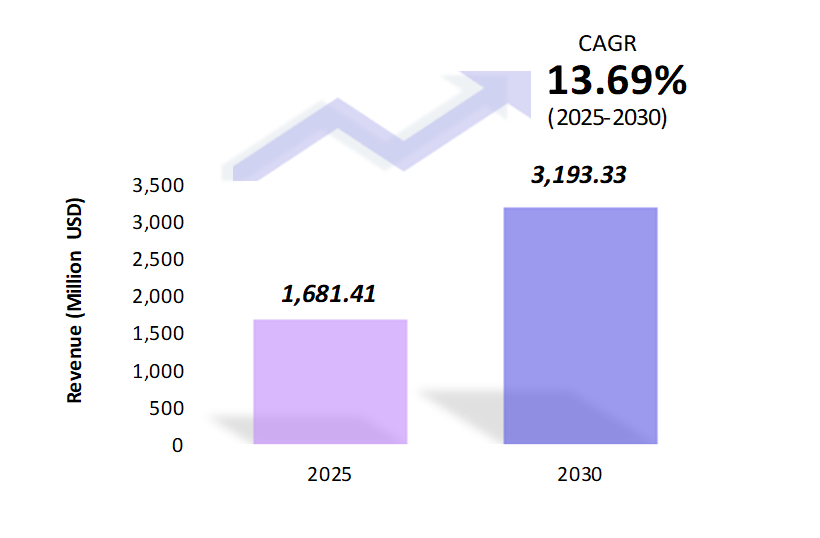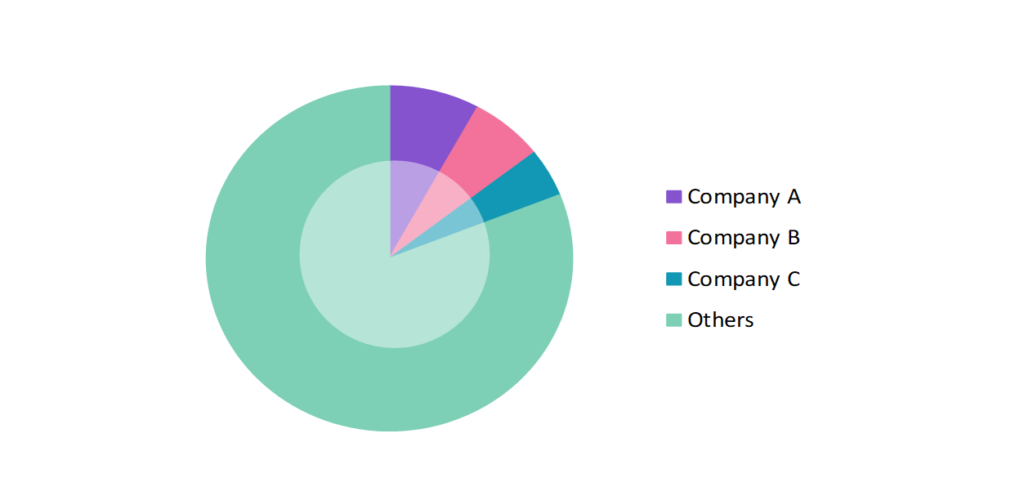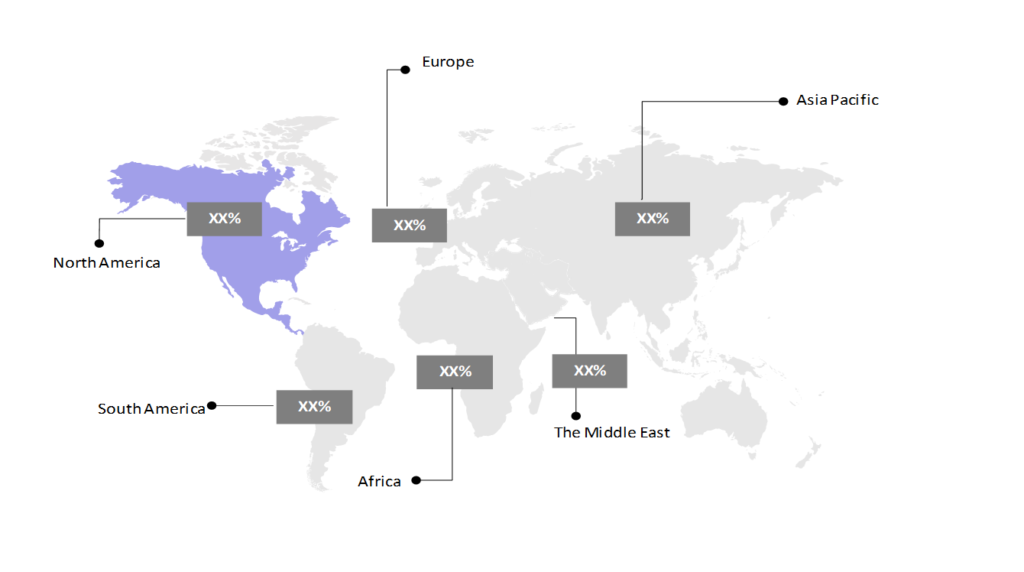Knowledge Graph Market Insights: Size, Share, Growth Analysis & Forecast (2024-2029)
The market report provided a comprehensive analysis segmented by Model Type (RDF Graph, Conceptual Graph, Semantic Graph); by Vertical (BFSI, IT & ITES, Retail and E-Commerce, Travel and Hospitality, Healthcare, Others); by Geography (North America, South America, Asia Pacific, Europe, The Middle East, Africa).
Outlook

- The knowledge graph market is estimated to be at USD 1,681.41 Mn in 2025 and is anticipated to reach USD 3,193.33 Mn in 2030.
- The knowledge graph market is registering a CAGR of 13.69% during the forecast period 2025-2030.
- The knowledge graph market is experiencing significant growth due to the rapid increase in data volume and complexity, coupled with advances in AI and machine learning. Organizations are leveraging knowledge graphs to manage large datasets, integrate real-time data, and drive more accurate decision-making. However, challenges such as data quality, scalability, and the high cost of development and maintenance hinder wider adoption, particularly for smaller businesses. Despite these hurdles, innovations like domain-specific knowledge graphs and linked data initiatives continue to push the market forward.
Request a free sample.
Ecosystem

- The participants in the global knowledge graph industry are always developing their strategies to preserve a competitive advantage.
- Companies with advanced AI and machine learning capabilities have a competitive edge, as these technologies drive automation in graph creation and maintenance. Firms that offer robust AI-driven tools for knowledge graph development are highly sought after for enterprise applications.
- Several important entities in the knowledge graph market include International Business Machines Corp.; Microsoft Corp.; Neo4j, Inc.; Tiger Graph, Inc.; SAP Group; and others.
Ask for customization.
Findings
| Attributes | Values |
|---|---|
| Historical Period | 2019-2023 |
| Base Year | 2024 |
| Forecast Period | 2025-2030 |
| Market Size (2025) | USD 1,681.41 Mn |
| Market Size (2030) | USD 3,193.33 Mn |
| Growth Rate | 13.69% CAGR from 2025 to 2030 |
| Key Segments | Model Type (RDF Graph, Conceptual Graph, Semantic Graph); Vertical (BFSI, IT & ITES, Retail and E-Commerce, Travel and Hospitality, Healthcare, Others); Geography (North America, South America, Asia Pacific, Europe, The Middle East, Africa) |
| Key Vendors | International Business Machines Corp.; Microsoft Corp.; Neo4j, Inc.; Tiger Graph, Inc.; SAP Group |
| Key Countries | The US; Canada; Mexico; Brazil; Argentina; Colombia; Chile; China; India; Japan; South Korea; The UK; Germany; Italy; France; Spain; Turkey; UAE; Saudi Arabia; South Africa |
| Largest Market | North America |
Get a free quote.
Trends
- Real-time Data Integration in Knowledge Graphs: Knowledge graphs are now capable of integrating real-time data streams, which makes them highly dynamic and up to date. This ensures that any new information is immediately reflected, which improves decision-making in fast-paced environments. Real-time integration also aids in maintaining context across connected datasets. Uber employs real-time data integration in their knowledge graphs to optimize route planning by analyzing real-time traffic conditions and customer requests.
- Hybrid Knowledge Graph Models: New hybrid models are emerging that combine structured and unstructured data, providing richer context and deeper insights. These models can better represent complex relationships that are not evident from structured data alone. This innovation improves applications such as content recommendations, fraud detection, and personalized experiences. Google Search uses hybrid knowledge graphs to merge structured web data with unstructured natural language queries, which provides more relevant and contextual search results.
- Domain-Specific Knowledge Graphs for Niche Applications: The development of domain-specific knowledge graphs is on the rise, tailored to specific industries like healthcare, finance, or retail. These specialized graphs offer higher precision and relevance in niche areas, which enhances the effectiveness of industry-specific AI tools. IBM Watson Health has created domain-specific knowledge graphs for healthcare, using medical literature and patient data to assist in diagnosis and treatment recommendations.
Speak to analyst.
Catalysts
- Rapid Growth in Data Volume and Complexity: The exponential increase in data volume and its complexity has driven the need for more efficient data organization and interpretation. Knowledge graphs offer a scalable solution to structure this vast and diverse data. This helps companies manage intricate relationships between different data points, which enables clearer insights and better decision-making. E-commerce company Amazon uses knowledge graphs to manage complex data from customer preferences, product inventories, and purchasing behaviors to enhance recommendations and improve customer experience.
- Advanced AI and ML Algorithms for Data Processing: The knowledge graph market is being propelled by the integration of advanced AI and machine learning (ML) algorithms for data processing. These technologies enhance data integration and semantic relationships, which enable organizations to uncover hidden insights from diverse sources.LinkedIn uses AI-driven knowledge graphs to build sophisticated connections between users, job listings, and industry trends, which improves recruitment processes and personalized content delivery.
- Semantic Web and Linked Data Initiatives: The increasing adoption of Semantic Web and Linked Data initiatives promotes the use of standardized formats to share and link data across domains. Knowledge graphs, which natively support linked data, enable enhanced interoperability and data enrichment by connecting disparate datasets. The European Union’s Open Data Portal uses linked data and semantic web standards in knowledge graphs to integrate public datasets across sectors, which fosters transparency and data-driven innovation across EU countries.
Inquire before buying.
Restraints
- Data Quality and Integration: Ensuring high data quality and seamless integration from diverse sources remains a major challenge in building effective knowledge graphs. Inconsistent data formats, incomplete information, and errors can undermine the accuracy of the graph. Aligning and standardizing data across various systems requires significant effort and sophisticated data cleansing techniques. Financial institutions integrating customer data from multiple systems into knowledge graphs struggle with inconsistencies, which leads to delays in customer insights and risk assessment.
- Difficulties in Scalability: As knowledge graphs grow in size and complexity, scaling them efficiently becomes difficult. Handling the massive influx of data while maintaining graph performance and query speed is resource intensive. The challenge is further compounded by the need for real-time updates, which can strain infrastructure and increase operational costs. Social media platform Twitter faces scalability issues when managing large knowledge graphs that continuously update in real time as user interactions and content surge.
- Significant Cost for Development and Maintenance: Developing and maintaining knowledge graphs can be expensive due to the need for advanced technology infrastructure, skilled professionals, and continuous updates. The complexity of maintaining the graph’s relevance, ensuring data freshness, and managing hardware requirements contribute to high operational costs, which makes it less accessible for smaller organizations. Startups often struggle with the high cost of implementing knowledge graphs, especially in industries like healthcare, where ongoing data updates and precision are critical for clinical decision-making tools.
Personalize this research.
Hotspot

Explore purchase options.
Table of Contents
| 1. Introduction 1.1. Research Methodology 1.2. Scope of the Study 2. Market Overview / Executive Summary 2.1. Global Knowledge Graph Market (2019 – 2023) 2.2. Global Knowledge Graph Market (2024 – 2030) 3. Market Segmentation 3.1. Global Knowledge Graph Market by Model Type 3.1.1. RDF Graph 3.1.2. Conceptual Graph 3.1.3. Semantic Graph 3.2. Global Knowledge Graph Market by Vertical 3.2.1. BFSI 3.2.2. IT & ITES 3.2.3. Retail and E-Commerce 3.2.4. Travel and Hospitality 3.2.5. Healthcare 3.2.6. Others 4. Regional Segmentation 4.1. North America 4.1.1. The US 4.1.2. Canada 4.1.3. Mexico 4.2. South America 4.2.1. Brazil 4.2.2. Argentina 4.2.3. Rest of South America 4.3. Asia Pacific 4.3.1. China 4.3.2. India 4.3.3. Rest of Asia Pacific 4.4. Europe 4.4.1. The UK 4.4.2. Germany 4.4.3. Italy 4.4.4. Rest of Europe 4.5. The Middle East 4.5.1. Turkey 4.5.2. UAE 4.5.3. Rest of the Middle East 4.6. Africa 4.6.1. South Africa 4.6.2. Rest of Africa 5. Value Chain Analysis of the Global Knowledge Graph Market 6. Porter Five Forces Analysis 6.1. Threats of New Entrants 6.2. Threats of Substitutes 6.3. Bargaining Power of Buyers 6.4. Bargaining Power of Suppliers 6.5. Competition in the Industry 7. Trends, Drivers and Challenges Analysis 7.1. Market Trends 7.1.1. Market Trend 1 7.1.2. Market Trend 2 7.1.3. Market Trend 3 7.2. Market Drivers 7.2.1. Market Driver 1 7.2.2. Market Driver 2 7.2.3. Market Driver 3 7.3. Market Challenges 7.3.1. Market Challenge 1 7.3.2. Market Challenge 2 7.3.3. Market Challenge 3 8. Opportunities Analysis 8.1. Market Opportunity 1 8.2. Market Opportunity 2 8.3. Market Opportunity 3 9. Competitive Landscape 9.1. International Business Machines Corp. 9.2. Microsoft Corp. 9.3. Neo4j, Inc. 9.4. Tiger Graph, Inc. 9.5. SAP Group 9.6. Company 6 9.7. Company 7 9.8. Company 8 9.9. Company 9 9.10. Company 10 |
Know the research methodology.
Knowledge Graph Market – FAQs
1. What is the current size of the knowledge graph market?
Ans. In 2025, the knowledge graph market size is USD 1,681.41 Mn.
2. Who are the major vendors in the knowledge graph market?
Ans. The major vendors in the knowledge graph market are International Business Machines Corp.; Microsoft Corp.; Neo4j, Inc.; Tiger Graph, Inc.; SAP Group.
3. Which segments are covered under the knowledge graph market segments analysis?
Ans. The knowledge graph market report offers in-depth insights into Model Type, Vertical, and Geography.
